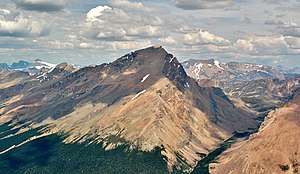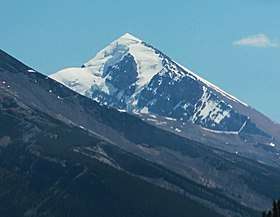Sunwapta Peak
Sunwapta Peak is a peak located in the Sunwapta River valley of Jasper National Park, just north of the Columbia Icefield in Alberta, Canada. The peak was named in 1892 after the Stoney Indian word "Sunwapta" meaning "turbulent river".[4] The mountain can be seen from the Icefields Parkway (Highway 93).
| Sunwapta Peak | |
|---|---|
 South Face of Sunwapta Peak seen from Tangle Ridge | |
| Highest point | |
| Elevation | 3,315 m (10,876 ft) [1][2] |
| Prominence | 1,014 m (3,327 ft) [1] |
| Coordinates | 52°20′55″N 117°16′30″W [3] |
| Geography | |
 Sunwapta Peak | |
| Parent range | Canadian Rockies |
| Topo map | NTS 83C/06[3] |
| Climbing | |
| First ascent | 1906 by Jimmy Simpson[1] |
| Easiest route | Easy scramble[4] |

Routes
The normal climbing route (an easy scramble) is via the southwest slopes, requiring an elevation gain of 1,735 m (5,692 ft) to the summit from the trail head located beside the Icefields Parkway.[4]
Geology
Sunwapta Peak is composed of sedimentary rock laid down from the Precambrian to Jurassic periods that was pushed east and over the top of younger rock during the Laramide orogeny.[5]
Climate
Based on the Köppen climate classification, Sunwapta Peak is located in a subarctic climate with cold, snowy winters, and mild summers.[6] Temperatures can drop below -20°C with wind chill factors below -30°C. Precipitation runoff from Sunwapta Peak drains into the Sunwapta River which is a tributary of the Athabasca River.
References
- "Sunwapta Peak". Bivouac.com. Retrieved 2009-01-02.
- "Sunwapta Peak". PeakFinder.com. Retrieved 2019-06-08.
- "Sunwapta Peak". Geographical Names Data Base. Natural Resources Canada. Retrieved 2019-06-08.
- Kane, Alan (1999). "Sunwapta Peak". Scrambles in the Canadian Rockies. Calgary: Rocky Mountain Books. pp. 312–313. ISBN 0-921102-67-4.
- Gadd, Ben (2008). "Geology of the Rocky Mountains and Columbias". Missing or empty
|url=(help) - Peel, M. C.; Finlayson, B. L. & McMahon, T. A. (2007). "Updated world map of the Köppen−Geiger climate classification". Hydrol. Earth Syst. Sci. 11: 1633–1644. ISSN 1027-5606.
External links
- Parks Canada web site: Jasper National Park